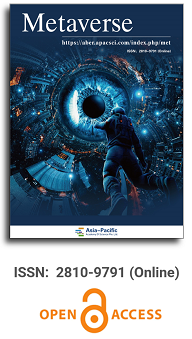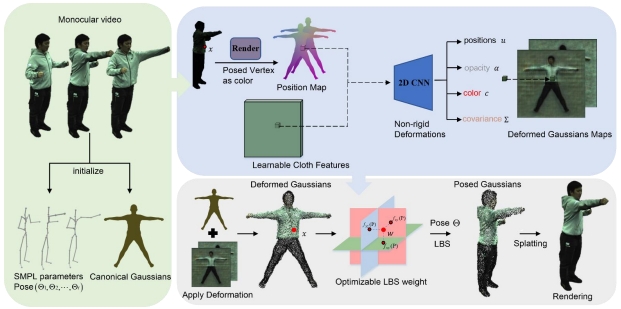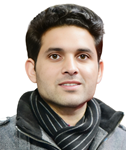
Asia Pacific Academy of Science Pte. Ltd. (APACSCI) specializes in international journal publishing. APACSCI adopts the open access publishing model and provides an important communication bridge for academic groups whose interest fields include engineering, technology, medicine, computer, mathematics, agriculture and forestry, and environment.



Metaverse is a brand new experience. Some people say that Metaverse is VR (Virtual Reality) and VR represents the Metaverse, some people say that the Metaverse is a 3D internet, and the VR/AR community is just the entrance or hardware infrastructure of the metaverse, i.e., the next-generation internet. So what exactly is the relationship between VR and the metaverse? What are the concrete applications of Metaverse in our life? Metavere Journal Office is honored to invite Dr. Muhammad Shahid Anwar from the Department of Artificial Intelligence and Software, Gachon University, South Korea, to express his opinions. 1. What are your research interests? My research interests are the measurement, modelling, and evaluation of the Quality of Experience (QoE) of Virtual Reality (VR) Videos, Augmented Reality (AR), immersive environment, Metaverse VR-based Education and Healthcare, Immersive media consumption and evaluation. 2. The relationship between your interests and Metaverse? AR/VR, 360-degree VR videos, and immersive environments are foundational components of the Metaverse. Each of these technologies contributes specific elements that, when combined, enrich and build the fabric of the Metaverse. VR provides completely simulated scenarios that transfer people into completely digital fields. These environments are frequently immersive, allowing users to interact with the simulated environments. Any immersive environment creates a sense of presence and engagement by allowing consumers to interact with their digital surroundings. They play a vital role in the making of rich, compelling Metaverse experiences. My research on measuring and improving QoE in immersive technologies is well aligned with the emerging Metaverse landscape. The Metaverse, which is comprised of interconnected virtual experiences, is primarily dependent on human participation and the overall experience within these digital domains. My emphasis on subjective and objective assessments, behavioral analysis, and psychophysiological evaluations precisely aligns with the Metaverse's goals for understanding and optimizing user interaction and experience. My Research study directly targets the essential pillars of generating engaging and seamless experiences within the Metaverse by investigating variables such as perceptual quality, immersion, presence, and even challenges that get cybersickness. My insights into human-technology behavior and approaches for increasing user delight while decreasing annoyance will become invaluable as this digital world evolves. Therefore, my research focus not only coincides with, but also helps considerably to the development and sustainability of user-centric, high-quality experiences inside the Metaverse's increasing domains. In the underlying structure of the Metaverse, these technologies work together to create diverse, interactive, and immersive digital worlds. They serve as the foundation for an interconnected, multidimensional world in which users can participate, interact, and experience a wide range of virtual settings and activities. The use of VR, AR, 360-degree movies, and immersive environments is critical to the development and fulfillment of the Metaverse concept. 3. How far do you think the metaverse is from people's daily lives? Are there any examples of applications that we can access? Hype? Hope? Reality? These challenging questions have been posed by the metaverse's developing landscape. One clear opinion emerges as experts debate its possible evolution: the increasing integration of augmented and mixed reality into daily life. The increasing value of this technology suggests a future in which the digital and physical worlds seamlessly merge, opening up a plethora of possibilities for social interaction, work, and entertainment. The recent growing excitement about the metaverse, particularly prompted by Facebook's rebranding to "Meta", has given attention to this subject matter, which was first introduced by Neal Stephenson in his 1992 novel "Snow Crash." The term "metaverse" refers to computer-generated, interconnected extended reality (XR), which includes augmented reality (AR), mixed reality (MR), and virtual reality (VR). It currently comprises mostly of semi-immersive XR worlds where individuals interact with automated entities. Some involve everyday interactions via augmented-reality apps on computers and phones, while others take place in more immersive game or fiction worlds. Certain exchanges even take place in "mirror worlds" that mimic real-life situations. The incorporation of these various types of XR represents a growing presence in people's life, a significant step toward broader daily integration. AR navigation tools and gaming experiences are noticeable examples of the Metaverse entering our daily lives, pointing at its gradual but noticeable convergence with ordinary life. All we need is a VR headset to virtually augment the real-world objects around us. Although the virtual world of Metaverse is not real, it is quite near. The Metaverse may become even more interesting as technology advances. As the Metaverse evolves, it has the ability to cross geographical divisions, providing greater communication for those separated by physical obstacles. Its transformative impact could revolutionize healthcare by enabling easier access to remote medical consultations, enabling seamless virtual shopping experiences, redefining workplace dynamics by fostering remote work environments, and even providing innovative solutions for personal styling and fashion consultancy. While the concept is still in its infancy, its trajectory points to a future in which the Metaverse fundamentally transforms the way people interact and engage with important services, thereby defining a global environment of unbeatable connection and accessibility. Several applications are already paving the way for the Metaverse to be integrated into our daily lives. Social VR Platforms such as VRChat and AltspaceVR provide social areas for users to communicate, interact and participate in various activities within a virtual environment. Decentraland and The Sandbox are simulated environments that allow users to create, own, and promote digital products and experiences, hence developing a virtual economy within the Metaverse.In the context of gaming and social platforms, the Roblox and Fortnite contain Metaverse aspects, offering not only game experiences but also social interactions, events, and the creation of creative material. Spatial Computing Apps use AR to allow distant collaboration in a shared virtual workspace. For remote work and meetings, certain enterprise platforms, such as Mozilla Hubs and MeetinVR, provide VR-based collaborative environments. Similiarly, for fashion and retail experiences, Ray-Ban and Sephora companies have developed AR applications that allow users to digitally put on spectacles and makeup. These applications are the first explorations into the Metaverse, demonstrating the potential for immersive, interconnected digital experiences that blur the boundaries between real and virtual realities. As technology improves, these examples lay the groundwork for future development and integration of the Metaverse into our daily lives. 4. Is it really possible to realize real feelings if we are in a virtual environment? The capability to feel true emotions in the context of the Metaverse, AR, and VR is an emerging concept that brings with it both opportunities and challenges. The concept of being able to experience "real feelings", "being in virtual world" or "sense of presence and immersion" in a virtual world is a complicated and challenging topic. The imitation of realistic sensory experiences, including sight and sound, has evolved greatly in today's VR and immersive digital worlds. Visual and auditory effects can be extremely convincing, creating a strong sense of presence and immersion. However, present technology has limitations when it comes to tactile experiences and emotional depth. The emphasis in today's AR and VR environments is mostly on visual and audio immersion, simulating a sensation of presence in digital spaces. Through immersive stories, engaging interactions, or captivating visuals and sounds. These technologies may generate strong emotional responses such as joy, excitement, terror, or empathy. However, replicating "real" emotions in a virtual world is difficult. While AR and VR can elicit strong emotions, they may not accurately duplicate the depth and complexity of emotions felt in the actual world. A variety of factors influence human emotions, including physical sensations, social interactions, and environmental stimuli, which are not entirely replicated in digital environments. Haptic feedback and sensory technologies are advancing to improve these experiences by replicating touch and sensations, potentially providing another degree of emotional immersion. Haptic equipment, like as gloves or vests try to imitate touch and physical sensations, so adding to a more complete sensory experience within VR. Furthermore, the future holds promise for more sophisticated interactions within these virtual worlds, potentially powered by AI, which might adapt and respond to users' emotions and behaviors, increasing the realism of emotional experiences within the Metaverse. Despite these developments, fully replicating real-world emotions within AMetaverse remains a difficult task. While these technologies provide significant emotional engagement, the full complexity and complexities of real-life emotions are diverse, influenced by an array of physical, social, and environmental aspects that are fundamentally difficult to replicate in a digital world. The ultimate goal of replicating real feelings within the Metaverse is a never-ending journey, with each technical progress bringing users closer to a more realistic and satisfying emotional experience within digital surroundings. 5. In which industry do you think Metaverse technology will first be widely used? The implementation of Metaverse technology is expected to have the greatest influence on the entertainment and gaming industries early. The Metaverse's immersive and interactive nature integrates well with gaming, allowing users to immerse themselves in highly fascinating and realistic virtual worlds. Furthermore, the entertainment companies are actively embracing AR and VR technology, placing it as a perfect starting point for widespread Metaverse use. As these technologies advance, it is projected that games, virtual events, live concerts, and interactive entertainment experiences will drive the first wave of Metaverse technology adoption. 6. What research topic are you currently working on? I am passionate about user research and user involvement in user-centric innovation processes and the activities are linked to human-technology experiences (Quality of Experience, User Engagement, and immersive experiences) and human-technology behavior, related methodological challenges. Several approaches are adopted for overall QoE evaluation, such as subjective and objective assessment, behavioral assessment, and psychophysiological assessment. I had also worked on QoE measurement and QoE-based optimization to foster user delight, reduce user annoyance, and to enable pleasurable immersive experiences. The system, human, and context factors influencing QoE for a range of applications and in different domains (e.g., 360-degree Virtual Reality Videos and immersive media, interactive services, Metaverse, and assistive technology in healthcare) were considered during the research. Different QoE influencing factors for Immersive environment and VR videos and aspects such as perceptual quality, immersion and presence, cybersickness, reality judgment, user engagement, and attention captivation were evaluated during several subjective experiments.
Dr. Muhammad Shahid Anwar is currently working as an assistant professor at Gachon University (Department of AI & Software), Seongnam, South Korea. He received a PhD degree in Information and Communication Engineering from the School of Information and Electronics, Beijing Institute of Technology, Beijing, China, in 2021 with a Thesis titled "QoE Evaluation of 360-degree Virtual Reality Videos". Previously, he received an M.Sc. degree in Telecommunications Technology from Aston University, Birmingham, U.K., in 2012. He has authored and co-authored more than 50 publications including IEEE, Springer, IET, Hindawi, MDPI, Frontiers journals, and flagship conference papers, and also published seven book chapters in reputed publisher. Dr. Muhammad Shahid Anwar has been serving as an editorial board member and guest editor in several journals and a reviewer of several journals including ACM and IEEE Transactions.
|

Prof. Zhigeng Pan
Director, Institute for Metaverse, Nanjing University of Information Science & Technology, China

Prof. Jianrong Tan
Academician, Chinese Academy of Engineering, China
Conference Time
December 15-18, 2025
Conference Venue
Hong Kong Convention and Exhibition Center (HKCEC)
...
Metaverse Scientist Forum No.3 was successfully held on April 22, 2025, from 19:00 to 20:30 (Beijing Time)...
We received the Scopus notification on April 19th, confirming that the journal has been successfully indexed by Scopus...
We are pleased to announce that we have updated the requirements for manuscript figures in the submission guidelines. Manuscripts submitted after April 15, 2025 are required to strictly adhere to the change. These updates are aimed at ensuring the highest quality of visual content in our publications and enhancing the overall readability and impact of your research. For more details, please find it in sumissions...







.jpg)
.jpg)

